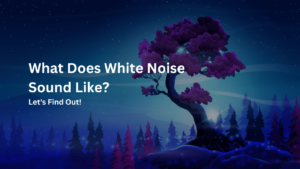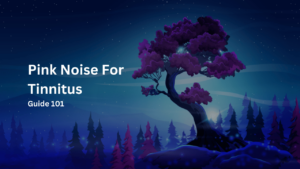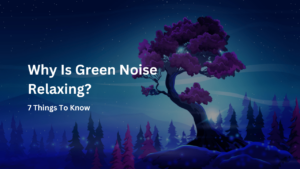Tinnitus, the perception of sound in the absence of an external source, often manifests as ringing, buzzing, or hissing in the ears.
It can significantly affect individuals’ quality of life, leading to challenges such as sleep disturbances, difficulty concentrating, and emotional stress.
Among various therapeutic sounds, brown noise has gained attention for its potential to alleviate tinnitus symptoms.
This comprehensive article delves into the nature of brown noise, its application in tinnitus management, and practical advice for individuals seeking relief.

What is Brown Noise?
Brown noise, also known as Brownian noise or red noise, is a deeper variant of white and pink noise, characterised by a stronger emphasis on lower frequencies. It resembles the sound of a deep, continuous rumble, akin to a strong wind or the deep roar of an ocean.
The power of brown noise decreases as the frequency increases, which results in a rich, calming sound that many find more pleasant and less intrusive than the higher frequencies found in white noise.
The Science Behind Brown Noise and Tinnitus Relief
Brown noise’s unique acoustic properties make it particularly effective for some individuals in managing tinnitus. Here’s an overview of how it can help:
Sound Masking
Similar to white noise, brown noise masks the internal sounds of tinnitus by providing an external, steady sound. Its deep tones can be especially effective for those whose tinnitus is perceived as high-pitched, offering a soothing contrast.
Neural Habituation
Listening to brown noise can aid in the process of neural habituation, helping the brain to gradually pay less attention to tinnitus sounds. Over time, this can lead to a decrease in the perceived intensity and annoyance of tinnitus.
Sleep Enhancement
The deep, consistent sound of brown noise can be particularly beneficial for individuals with tinnitus struggling with sleep. Its soothing qualities can help mask tinnitus sounds that are more noticeable in quiet environments, promoting relaxation and making it easier to fall asleep.
Cognitive Distraction
Brown noise can also serve as a cognitive distraction, diverting the listener’s attention away from tinnitus and reducing the focus on the condition. This can be particularly useful for improving concentration or when seeking relaxation.
Incorporating Brown Noise into Tinnitus Management
For those interested in exploring brown noise as a part of their tinnitus management strategy, here are some practical tips:
Finding the Right Sound
Experiment with different sources of brown noise to find the one that’s most soothing for you. Many online platforms, apps, and sound machines offer a variety of brown or Green noise tracks.
Volume Considerations
It’s crucial to listen to brown noise at a safe volume to avoid further hearing damage. The sound should be loud enough to mask tinnitus without overwhelming it. Consulting with an audiologist can help determine the appropriate volume level.
Consistent Usage
Regular exposure to brown noise can enhance its effectiveness in managing tinnitus. Consider incorporating it into your daily routine, especially during periods of quiet or before sleep.
Combining with Other Therapies
Brown noise can be part of a broader tinnitus management plan that includes other therapies such as Tinnitus Retraining Therapy (TRT), Cognitive Behavioral Therapy (CBT), and hearing aids, if applicable.
Personal Experiences and Professional Guidance
While many individuals report positive effects from using brown noise for tinnitus, experiences can vary. It’s important to approach this as one component of a comprehensive management strategy and to seek professional guidance. An audiologist or a tinnitus specialist can offer personalized advice and support, ensuring that your approach to managing tinnitus is both safe and effective.
Frequently Asked Questions (FAQs)
Ques 1: Does brown noise help tinnitus?
Ans: Yes, brown noise which focuses on lower frequencies can help mask tinnitus noise and aid sleep in some people. It’s relaxing and less harsh at higher volumes than white noise.
Ques 2: What color sounds best for tinnitus?
Ans: Experts often recommend trying different color noises to find what works best for each individual. Using Green noise in tinnitus or pink noise for tinnitus relief is considered good apart from brown noise.
Ques 3: What noise cancels out tinnitus?
Ans: White noise generators, specialised sound therapies involving notched music, and devices creating masking stimuli tuned to one’s hearing can cancel out phantom ringing or buzzing.
Ques 4: Is brown noise harmful to ears?
Ans: No, at moderate volumes brown noise is not known to cause hearing damage or tinnitus. Avoid very loud volumes for extended periods.
Ques 5: What is the best sound for tinnitus sleep?
Ans: Soothing green noise and background sounds like light rain, ocean waves, steady drones or soft music help many with tinnitus sleep better by masking the ear noise.
Ques 6: Can pink noise cure tinnitus?
Ans: There is no known cure yet, but steady pink noise exposure trains the brain to ignore tinnitus sound, providing long-term relief for many.
Conclusion
Brown noise presents a promising option for individuals seeking relief from tinnitus. Its deep, soothing tones can mask the sounds of tinnitus, aid in sleep, and provide a calming background for daily activities.
As with any tinnitus management technique, individual experiences may differ, and professional consultation is recommended to tailor the approach to your specific needs. By integrating brown noise into a holistic management plan, individuals with tinnitus can find meaningful relief and improve their overall quality of life.



